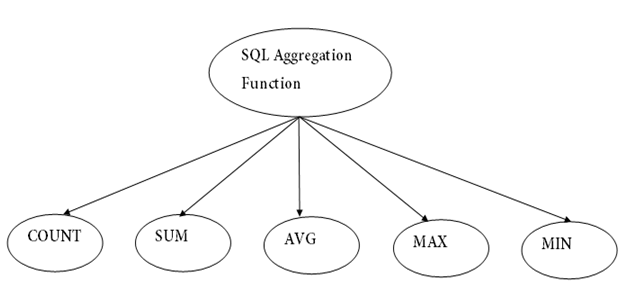SQL Aggregate Functions
- SQL aggregation function is used to perform the calculations on multiple rows of a single column of a table. It returns a single value.
- It is also used to summarize the data.
Types of SQL Aggregation Function

1. COUNT FUNCTION
- COUNT function is used to Count the number of rows in a database table. It can work on both numeric and non-numeric data types.
- COUNT function uses the COUNT(*) that returns the count of all the rows in a specified table. COUNT(*) considers duplicate and Null.
Syntax
Sample table:
PRODUCT_MAST
| PRODUCT | COMPANY | QTY | RATE | COST |
|---|---|---|---|---|
| Item1 | Com1 | 2 | 10 | 20 |
| Item2 | Com2 | 3 | 25 | 75 |
| Item3 | Com1 | 2 | 30 | 60 |
| Item4 | Com3 | 5 | 10 | 50 |
| Item5 | Com2 | 2 | 20 | 40 |
| Item6 | Cpm1 | 3 | 25 | 75 |
| Item7 | Com1 | 5 | 30 | 150 |
| Item8 | Com1 | 3 | 10 | 30 |
| Item9 | Com2 | 2 | 25 | 50 |
| Item10 | Com3 | 4 | 30 | 120 |
Example: COUNT()
Output:
10
Example: COUNT with WHERE
Output:
7
Example: COUNT() with DISTINCT
Output:
3
Example: COUNT() with GROUP BY
Output:
Com1 5 Com2 3 Com3 2
Example: COUNT() with HAVING
Output:
Com1 5 Com2 3
2. SUM Function
Sum function is used to calculate the sum of all selected columns. It works on numeric fields only.
Syntax
Example: SUM()
Output:
670
Example: SUM() with WHERE
Output:
320
Example: SUM() with GROUP BY
Output:
Com1 150 Com2 170
Example: SUM() with HAVING
Output:
Com1 335 Com3 170
3. AVG function
The AVG function is used to calculate the average value of the numeric type. AVG function returns the average of all non-Null values.
Syntax
Example:
Output:
67.00
4. MAX Function
MAX function is used to find the maximum value of a certain column. This function determines the largest value of all selected values of a column.
Syntax
Example:
30
5. MIN Function
MIN function is used to find the minimum value of a certain column. This function determines the smallest value of all selected values of a column.
Syntax
Example:
Output:
10




No comments:
Post a Comment